Forum on trading, automated trading systems and testing trading strategies
newdigital, 2013.10.15 06:20
A Basic Breakout Strategy For Forex
Talking Points:
- Forex tips for finding support and resistance levels.
- Learn to enter Forex breakouts using Donchian Channels.
- Complete a breakout trading plan with stop orders.
The Forex market is known for its strong trends, which can make trading a breakout strategy an effective approach to the markets. Normally the first step of any breakout strategy is to identify the key levels of support and resistance for a currency pair. Today we are going to review using Donchian Channels for just that purpose, while complete a trading setup on the GBPUSD.
Let’s get started!
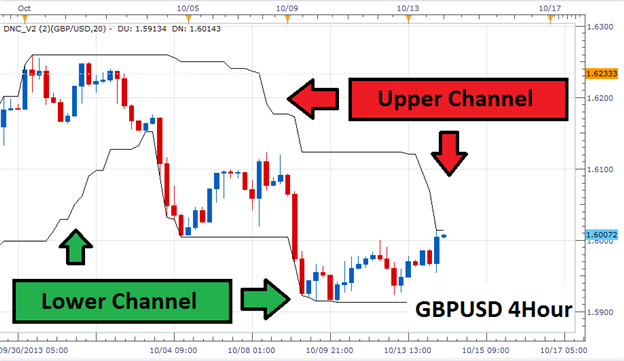
Trading Donchian Channels
Donchian Channels can be applied to any chart to extrapolate current
levels of support and resistance. They do this by clearly identify the
high and low on a graph created during the selected number of periods.
Above we can see the Donchian Channels applied to a GBPUSD 4Hour chart,
using a 20 period setting. The channel lines highlight the current 20
periods high and low values, which can be used as support and resistance
when trading breakouts. Breakout traders in a downtrend will look for
price to break below the lower channel prior to creating new entries in
the direction of the trend. The same is true in an uptrend, where
traders will identify the upper channel as a potential area to enter the
market.
Since the price of the GBPUSD has declined as much as 346 pips for the month of October, many traders will want to identify new entries to sell the pair on a breakout towards lower lows. With our current low already identified by the Donchian Channels at 1.5913, traders can begin preparing for a breakout below this value. As pictured below, you can find a sample breakout setup. Entry orders to sell the GBPUSD can be placed at a minimum of one pip below support, so traders enter the market on a breakout to lower lows.
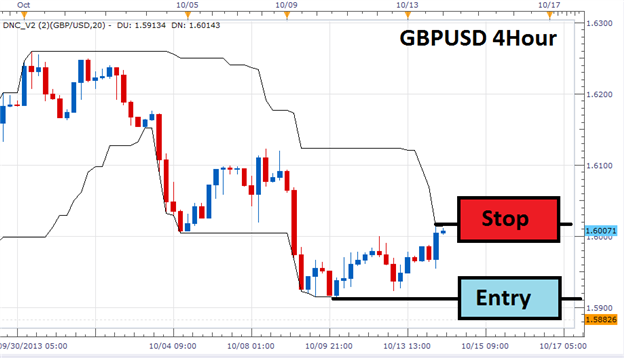
Setting Risk
As with any strategy, breakout traders should incorporate stops into
their trading. When using Donchian Channels, this process can be made
very easy. Remember how the top pricing channel (representing the 20
period high), acts as an area of resistance? In a downtrend price is
expected to make lower lows and stay below this value. If a new high is
created, with a breach of the upper channel, traders will want to exit
their positions. Traders may also want to manually tail and move their
stop order to lock in profit as the trend continues. On trading tip
breakout traders can employ is moving this preset stop along with the
decreasing pricing channel as the trade moves in their favor.
Forum on trading, automated trading systems and testing trading strategies
newdigital, 2014.01.18 07:34
How to use Donchian Channels (adapted from dailyfx article)
- First find the trend to determine the trend
- Learn to enter Forex breakouts using Donchian Channels.
- Channels can be used to trail your stop and lock in profit.
The Forex market is known for its strong trends, which can make trading breakouts of support and resistance levels an effective approach to the markets. To plan for such market conditions, today we will review a three step breakout strategy using the Donchian Channels.
Find the Trend
The first step to trend trading is to find the trend! There are many
ways to identify the trends depicted below, but one of easiest is
through the use of the 200 period MVA (Moving Average). To begin add
this indicator to your chart, and then see if price is above or below
the average. This is how we will determine the trend and our trading
bias.
Given the information above, traders should look for opportunities to buy the EURJPY in its current uptrend as price is above the average. As well, the AUDNZD pictured below offers selling opportunities since the pair is priced under the 200 period MVA. Once we have this information, then we can plan entry placements for a potential breakout.

Trading Donchian Channels
Donchian Channels are a technical tool that can be applied to any chart.
They are used to pinpoint current levels of support and resistance by
identifying the high and low price on a graph, over the selected number
of periods. For today’s strategy we will be using 20 periods meaning
that the channels will be used to identify the 20 day high and low in
price.
Since the price of the EURJPY is trading above the 200 MVA, traders will want to identify new entries to buy the pair on a breakout towards higher highs. With our current 20 Day high identified by the Donchian Channels at 145.68 traders can set an entry to buy the EURJPY one pip above this value.
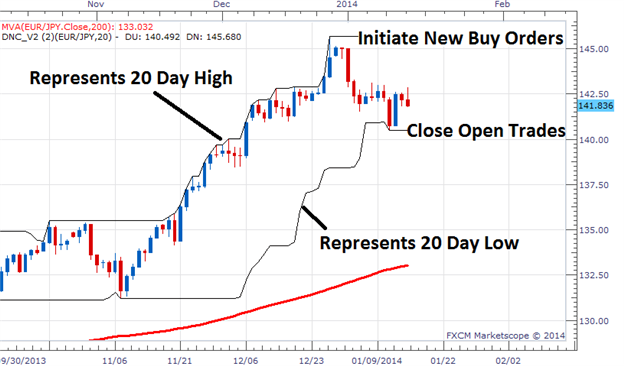
The process of initiating sell positions in a downtrend is exactly the opposite. Again, we will revisit the AUD/NZD Daily graph pictured below. As price is below the 200 MVA, traders will look to sell the pair in the event of price creating a new 20 Day low. Currently that low resides at .8775 and traders can look to initiate new sell positions under that value.
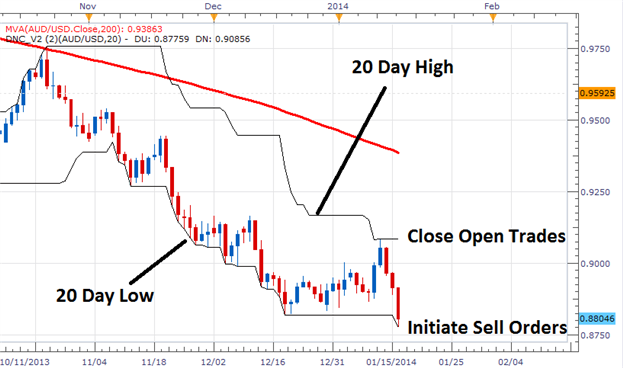
Setting Risk & Trailing Stops
When trading any strategy, setting stops and managing risk should be
considered. When using Donchian Channels, this process can be
simplified. Remember how our pricing channels (representing the 20 Day
high or low), act as an area of support or resistance? In an uptrend,
price is expected to move to higher highs and stay above this value. If
price moves through the bottom channel, representing a new 20 Day low,
traders will want to exit any long positions. Conversely in a downtrend,
traders will want to place stops orders at the current 20 period high.
This way, traders will exit any short positions upon the creation of a
new high.
Traders may also use the Donchian Channels as a mechanism to trail their
stop. As the trend continues, traders may move their stop along with
the designated channel. Trailing a stop in this manner will allow you to
update the stop with the position, and lock in profit as the trend
continues.
Forum on trading, automated trading systems and testing trading strategies
newdigital, 2014.01.18 07:39
After reading this article (above) - you/we can open D1 chart, attached Donchian Channel indicator (see first post of this thread), attach MA with the period 200/method simple.apply to close (this indicator is default one in Metatrader 5) - and we can make some practics (when market will be open). You should have the similar charts after attaching those 2 indicators:
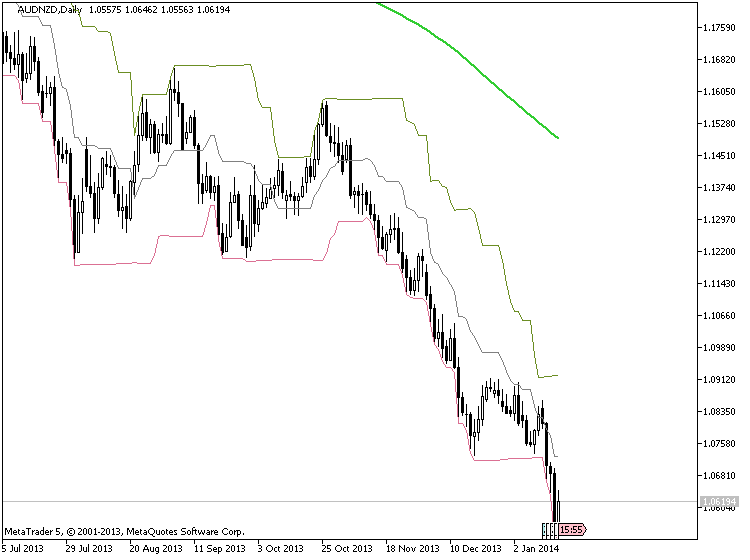
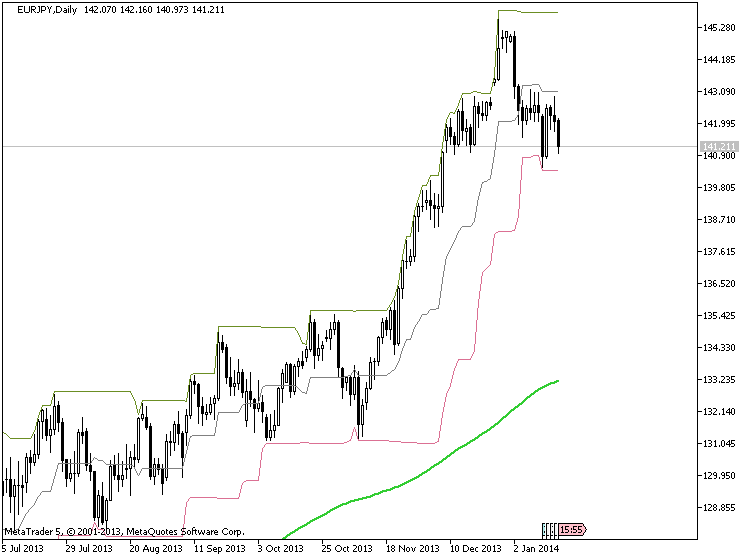
After that - re-read this above article using your Metatrader charts.
That's all news
Forum on trading, automated trading systems and testing trading strategies
Indicators: Donchian Channels System
newdigital, 2014.04.16 09:09
The 3 Step Breakout Strategy (adapted from dailyfx article)
- Volatility breeds breakout trading opportunities.
- 24-period Donchian Channel on an Hourly chart can give us medium term trade entries.
- Stops can be set opposite of the channel break using 1:2 risk and reward ratio.
Step 1: Look for Volatility
Not all market conditions are ripe for breakout trading. We need to first find the pairs that have shown the most volatility.
Step 2: Find Trade Entries Using Donchian (Price) Channels
Support and resistance levels are subjective and can vary from trader to trader. So to more clearly define our entry levels, we use Donchian Channels or Price Channels.
Step 3: Easy Exits Using Stops and Limits
No strategy is complete without an exit strategy. Fortunately, the
Donchian Channel can assist in setting one up. We first want to focus on
our stop. I recommend setting our stop loss beyond the other side of
the channel. So if the price broke below the bottom line and created a
sell trade, we would set our stop a few pips above the top line. If
price broke above the top line and created a buy trade, we would set our
stop a few pips below the bottom line.
- Free trading apps
- Over 8,000 signals for copying
- Economic news for exploring financial markets
You agree to website policy and terms of use
CDonchian class:
Uses the idea of the classical Donchian channel.
The class is optimized by speed, i. e. instead of 2 for loops, 1 while loop is executed.
Author: Ekaterina Hinkel